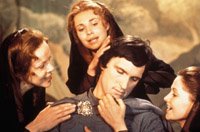 The Magic Flute (Trollflöjten) (1975)
The Magic Flute (Trollflöjten) (1975)Director: Ingmar Bergman
On January 27, millions of people all over the world celebrated the 250th birthday of one of the greatest composers ever to live, Wolfgang Amadeus Mozart. I listened to my radio, whose signal was made scratchy and fickle by the computer equipment and tall buildings in and around my place of work, to hear the live broadcast feed through my local classical radio station, WFMT-FM, from Salzburg, Austria, the place Mozart called home. Many luminaries of the classical music world were on hand in Salzburg to pay tribute to the glory of Mozart. I was moved to pay "Wolfie" homage in my own way, through film.
Amadeus was an obvious choice for viewing, but I have seen it several times and, frankly, I was more interested in Mozart's music than in a fictional Mozart. Searching IMDb, I found what I was looking for--in spades! The Magic Flute, one of my very favorite pieces of music, had been filmed for television by none other than the great Swedish director Ingmar Bergman. Fascinated by the possibilities of the joyous strains of Mozart's fairytale opera as interpreted by one of cinema's most penetratingly dour directors, I couldn't wait to lay hands on the film. I located a DVD of it--a Criterion disc no less!--at my local library and snatched it up before some other Mozart fan claimed it for the day. Thus armed, I settled down for an evening of basking in the artistry of two geniuses.
Filming works meant for the stage has been problematic for directors throughout the years. Many early films, such as the 1924 silent version of Peter Pan, chose to record the stage play straight on, as though the crew and film's audience were in the auditorium. Other films go to the opposite extreme of "opening up" the play and shooting in natural settings away from stages, such as Kenneth Branagh's 1993 version of Much Ado About Nothing. It would have been easy to take the fanciful The Magic Flute into a forest or a castle and give it a more visceral feel, but Bergman chose a hybrid approach. He staged the opera in a replica of Stockholm's Drottningholm Court Theatre, with sets and backdrops made to match that theatre's whimsical creations. At the same time, he filmed the singers largely in close-up as they lipsynched to a soundtrack they recorded first, and edited to create an engaging movie that stands up respectably against the rest of his cinematic output. Thus, we are able to appreciate the medium of opera as it was meant to be seen--on a stage--but enjoy the dramatic possibilities of film, which can envelope us in the action, the better to involve us emotionally in the fate of the central characters.
The story revolves around the quest of Prince Tamino (Josef Köstlinger) to claim Princess
 Pamina (Irma Urrila) as his own. Pamina's mother, the Queen of the Night (Birgit Nordin), has contrived for Tamino to fall in love with her at first sight by giving him a magic amulet that contains her animated picture. The queen has her own agenda--to gain the return of her daughter before she destroys the world of Pamina's captor, Sarasto (Ulrik Cold), who is the queen's husband and Pamina's father. The queen gives Tamino a magic flute to protect him from Sarastro and also sends her love-starved birdcatcher Papageno (Håkan Hagegård) to help.
Pamina (Irma Urrila) as his own. Pamina's mother, the Queen of the Night (Birgit Nordin), has contrived for Tamino to fall in love with her at first sight by giving him a magic amulet that contains her animated picture. The queen has her own agenda--to gain the return of her daughter before she destroys the world of Pamina's captor, Sarasto (Ulrik Cold), who is the queen's husband and Pamina's father. The queen gives Tamino a magic flute to protect him from Sarastro and also sends her love-starved birdcatcher Papageno (Håkan Hagegård) to help. The opera mixes fancy with Freemasonry and the traditional hero's quest--which had me thinking how glad I was not to be watching the ponderous Wagner operas (Siegfried or Parsifal, for example) dealing with similar quests. The libretto, translated into Swedish, retains the beautiful poetry and spirit of the original by Emanuel Schikaneder (and unfortunately, the misogyny). Bergman makes an unusual choice of using title cards under certain arias, like sub- or supertitles now common in opera houses but almost unheard of at the time this film was made. I really didn't understand their inclusion, other than that they seemed to emphasize certain lessons Mozart wished to make clear about human nature and its joys and pitfalls. The singers seemed quite amused to be flipping these cards in front of them, and that lent to the general joviality of the presentation.
A less fortunate, but perhaps understandable choice, was to film a huge variety of faces--the audience, apparently--as they listened to the overture. I was reminded of the love Fellini had of faces and how he would audition hundreds of people in a day to find the right faces with which to populate his films. I think Bergman meant to suggest the universality of Mozart, though he chooses a very Swedish-looking child to be the audience representative to whom he cuts at various points of the scenario. In my opinion, these audience shots were unnecessary (but then what does one do about the overture?), but they might have had a welcoming effect in Swedish homes where classical music isn't a high priority. His backstage revelations during the intermission of life imitating art (the singers who play Pamina and Tamino are actually in love; Papageno is actually a layabout) also were unnecessary and revealed a filmmaker a bit uncomfortable relying solely on music to entertain and instruct.
In the end, however, this film is an engrossing version of a delightful classic opera. The voices generally are good in both sound and interpretation, with special kudos to bass Ulrik Cold as Sarastro and tenor Håkan Hagegård, who was an irresistable Papageno. However, this is not the
 complete opera, and some of the cuts and watered-down characterizations, particularly the threatening characters of the Queen of the Night and the moor Monostatos, weaken the darker elements of the opera and make one wonder what all the fuss is about. But only hardcore opera fans will complain. This Magic Flute still bewitches. l
complete opera, and some of the cuts and watered-down characterizations, particularly the threatening characters of the Queen of the Night and the moor Monostatos, weaken the darker elements of the opera and make one wonder what all the fuss is about. But only hardcore opera fans will complain. This Magic Flute still bewitches. l


0 Comments:
Post a Comment
<< Home